[Day11]程序菜鸟自学C++资料结构演算法 – 伫 列Queue
前言:上一篇结束了堆叠的实作,今天要来介绍新东西「伫列」。
伫列的特性:伫列和堆叠非常类似,同样都是有序串列(元素以某种顺序排列 ,该顺序具有一定的意义,不可错置),且同样属於抽象资料型态。
伫列与堆叠的差别在於伫列为「先进先出(FIFO,First In First Out)」,就好比先排队的人先买到门票一样。

图片来源:http://runningmanmacau.weebly.com/uploads/2/7/2/0/27203993/s416834513424666157_p2_i1_w640.jpeg
如果以电脑的角度来看,堆叠的新增和删除只能发生在头节点,而伫列多了一个後端指标负责新增资料,前端指标用来读取和删除。

环状伫列:伫列的实际应用之一,经常用於行车纪录器或监视器之类的装置,储存特定天数的资料,若天数已满则将第一天从前端删除,并从末端加入新的一天。
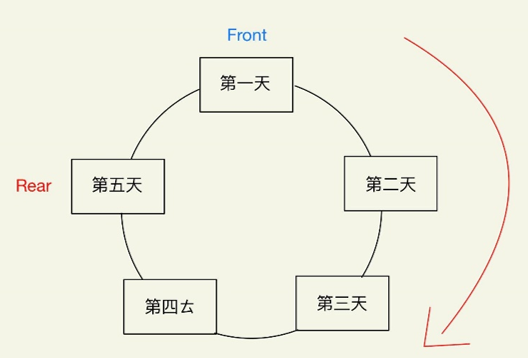
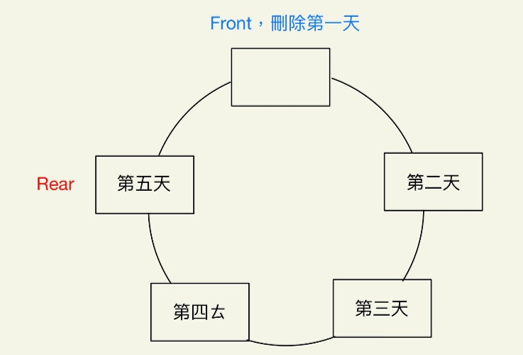
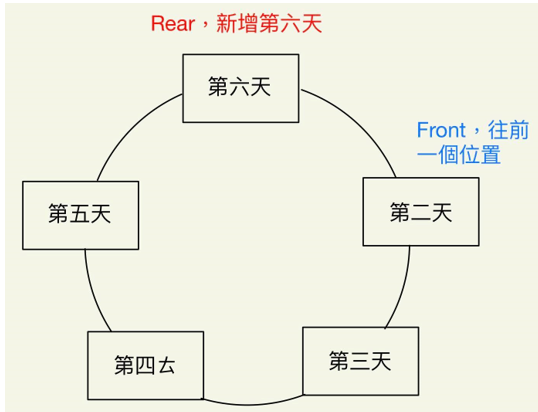
依照这样的做法就能成功创建了喔!
接着就实际操作看看,一样要先创建新的专案୧| ” •̀ ل͜ •́ ” |୨
伫列:
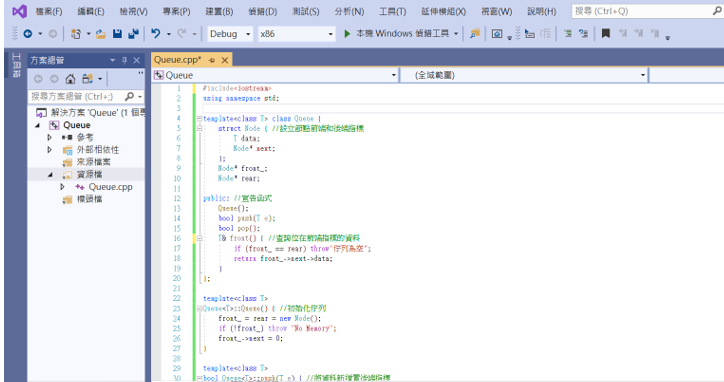
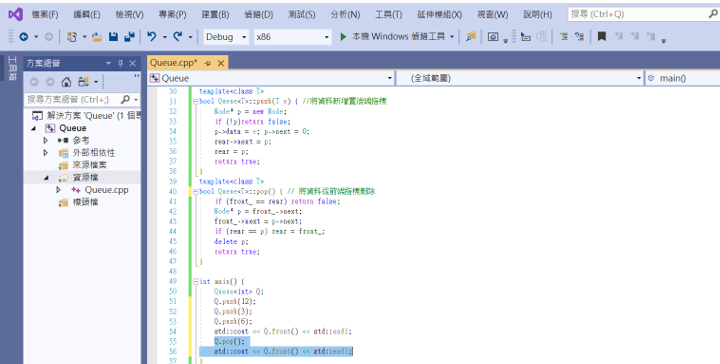
std::cout << Q.front() << std::endl;为显示伫列前端指标的资料,所以可以看到12位在伫列最前端,将其pop之後最前端的位置就变为3。

也可持续pop直到伫列为空的,首先要判断伫列是否没有资料。
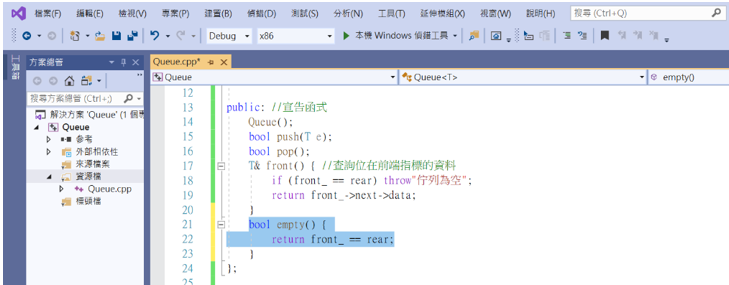
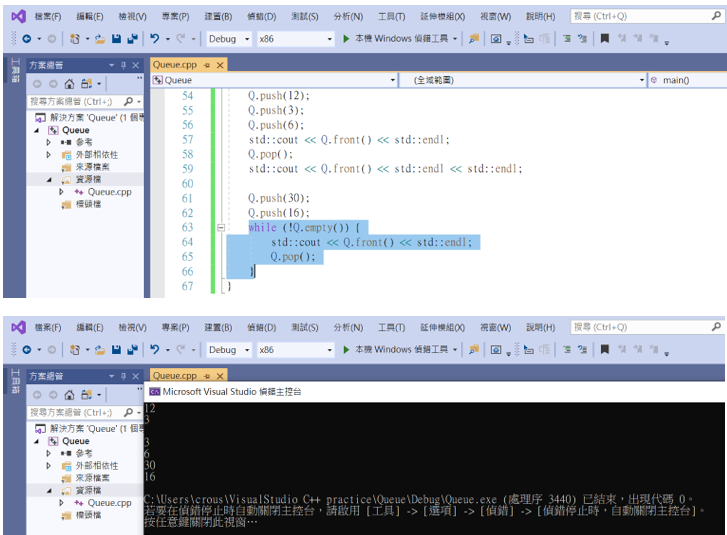
这样就完成最初始的伫列了喔,紧接着就来挑战进阶一些的环状伫列。
环状伫列:
直接在资源档中新增项目即可,不需要创建新的专案。但同样一个专案不能有两个main程序,如果不知道怎麽操作的,可以看看上一篇文章
之後就可以开始实作了。
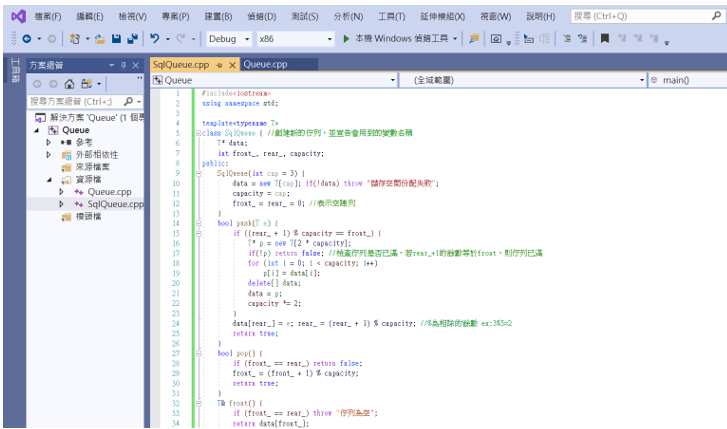
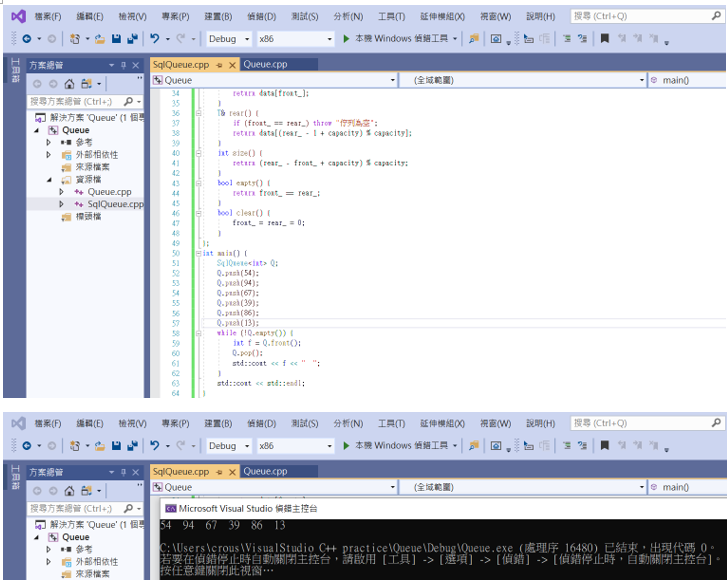
因为是环状伫列,所以也可以从末端查询资料。
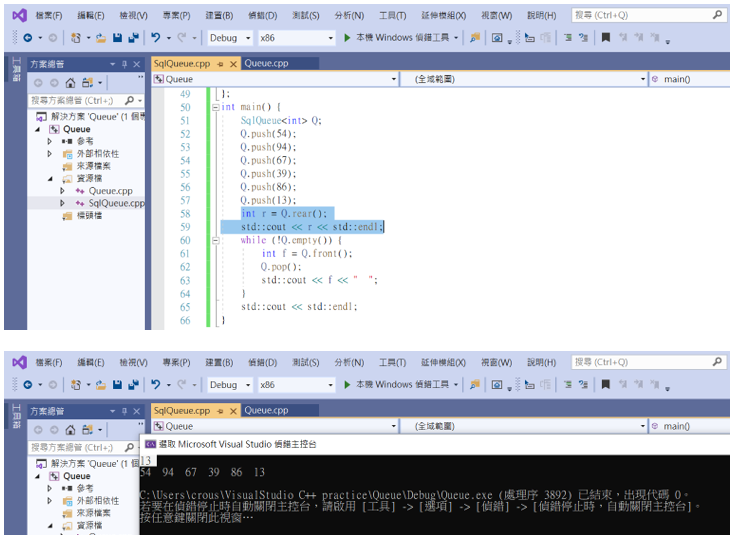
这样就完成了喔!
本日小结:今天做完了伫列和循环伫列,循环伫列和伫列的概念非常类似,但是如果要对循环伫列进行新增和删除的话,都必须要用除以容量的余数去考虑,这个部分比较复杂,需要花时间理解,伫列还有一些东西没讲到,会在之後的文章说明,明天将要进入资料结构中最重要的一环「树」的部分१|˚–˚|५
伫列
#include<iostream>
using namespace std;
template<class T> class Queue {
struct Node { //设立节点前端和後端指标
T data;
Node* next;
};
Node* front_;
Node* rear;
public: //宣告函式
Queue();
bool push(T e);
bool pop();
T& front() { //查询位在前端指标的资料
if (front_ == rear) throw"伫列为空";
return front_->next->data;
}
bool empty() {
return front_ == rear;
}
};
template<class T>
Queue<T>::Queue() { //初始化伫列
front_ = rear = new Node();
if (!front_) throw "No Memory";
front_->next = 0;
}
template<class T>
bool Queue<T>::push(T e) { //将资料新增置後端指标
Node* p = new Node;
if (!p)return false;
p->data = e; p->next = 0;
rear->next = p;
rear = p;
return true;
}
template<class T>
bool Queue<T>::pop() { // 将资料从前端指标删除
if (front_ == rear) return false;
Node* p = front_->next;
front_->next = p->next;
if (rear == p) rear = front_;
delete p;
return true;
}
int main() {
Queue<int> Q;
Q.push(12);
Q.push(3);
Q.push(6);
std::cout << Q.front() << std::endl;
Q.pop();
std::cout << Q.front() << std::endl << std::endl;
Q.push(30);
Q.push(16);
while (!Q.empty()) {
std::cout << Q.front() << std::endl;
Q.pop();
}
}
环状伫列
#include<iostream>
using namespace std;
template<typename T>
class SqlQueue { //创建新的伫列,并宣告会用到的变数名称
T* data;
int front_, rear_, capacity;
public:
SqlQueue(int cap = 3) {
data = new T[cap]; if(!data) throw "储存空间份配失败";
capacity = cap;
front_ = rear_ = 0; //表示空阵列
}
bool push(T e) {
if ((rear_ + 1) % capacity == front_) {
T* p = new T[2 * capacity];
if(!p) return false; //检查伫列是否已满,若rear_+1的余数等於front,则伫列已满
for (int i = 0; i < capacity; i++)
p[i] = data[i];
delete[] data;
data = p;
capacity *= 2;
}
data[rear_] = e; rear_ = (rear_ + 1) % capacity; //%为相除的余数 ex:3%5=2
return true;
}
bool pop() {
if (front_ == rear_) return false;
front_ = (front_ + 1) % capacity;
return true;
}
T& front() {
if (front_ == rear_) throw "伫列为空";
return data[front_];
}
T& rear() {
if (front_ == rear_) throw "伫列为空";
return data[(rear_ - 1 + capacity) % capacity];
}
int size() {
return (rear_ - front_ + capacity) % capacity;
}
bool empty() {
return front_ == rear_;
}
bool clear() {
front_ = rear_ = 0;
}
};
int main() {
SqlQueue<int> Q;
Q.push(54);
Q.push(94);
Q.push(67);
Q.push(39);
Q.push(86);
Q.push(13);
int r = Q.rear();
std::cout << r << std::endl;
while (!Q.empty()) {
int f = Q.front();
Q.pop();
std::cout << f << " ";
}
std::cout << std::endl;
}
不只懂 Vue 语法:为何懒加载路由和元件会提升网页效能?
问题回答 懒加载路由或元件的意思是当访问该路由,或需要显示该元件时,才载入该路由或元件。这做法会提升...
如何使用 UML 序列图对 MVC 框架进行建模?
MVC(或模型-视图-控制器)是一种流行的软件框架,用於成功有效地将用户界面与底层数据模型相关联。由...
Day 06 Heroku、Heroku CLI、Git push建置
创建Heroku APP https://www.heroku.com/ 进入网站注册并登入Hero...
Day-24 快速面试之考题大公开!(3)
听听其他人对於快速面试的应对。 有被问到专案的优化方式如何,当时我答不好(冏)後来听到组员回答的很...
Day14: Inspector简介
What is Inspector? Amazon Inspector 安全评估可协助您检查 Ama...